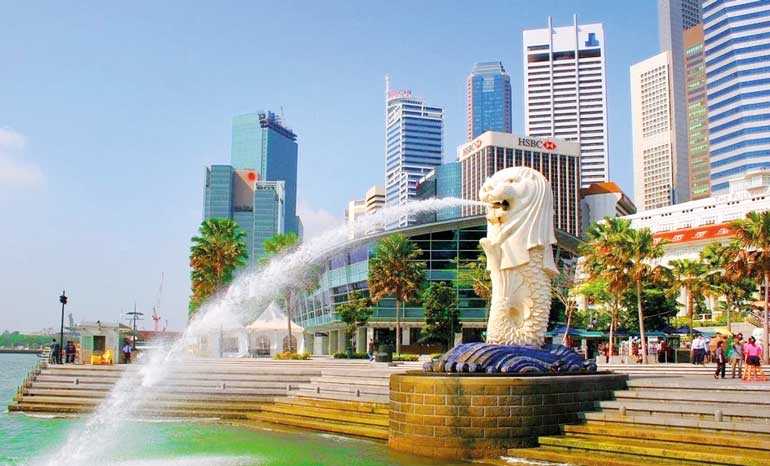Wednesday Feb 12, 2025
Wednesday Feb 12, 2025
Thursday, 2 August 2018 00:00 - - {{hitsCtrl.values.hits}}


By Ganeshan Wignaraja
and Amitendu Pali
Sri Lanka and Singapore have recently signed a bilateral free trade agreement (SLSFTA). Apart from being a comprehensive and modern FTA in scope and coverage, the SLSFTA paves the way for Sri Lanka’s greater integration with ASEAN and possible future entry in RCEP. Reflecting on the challenges for optimising the benefits of SLSFTA, this paper argues a successful SLSFTA would vindicate the region’s confidence in virtues of free trade.
While the global trade war threatens to disrupt the momentum of global trade and the prospects of global economic growth, encouraging signs of commitment to trade are visible elsewhere. Countries across the world continue to remain committed to free trade, notwithstanding anxieties over the course of the trade war and its greater impact on global commerce. The EU and Japan have just signed a bilateral free trade agreement (FTA), paving the way for unrestricted trade within their combined economies of more than $ 20 trillion. The growth of a preferential trading bloc between Europe and Asia, as represented by the EU-Japan FTA, would produce considerable energy for trade prospects in the Asia-Pacific. The prospects also stand to augment from another bilateral FTA that came into effect in May 2018 – the Sri Lanka- Singapore FTA (SLSFTA).
Structure and Character
While the economic size of the Singapore-Sri Lanka FTA is not comparable to that of the EU- Japan FTA, or any of the ASEAN +1 FTAs, it is notable for various reasons. It is Sri Lanka’s first FTA since 2005 and the most comprehensive among the handful it has signed so far. The FTA not only includes traditional trade issues like trade in goods, trade remedies, trade facilitation and dispute settlement, but also covers trade in services, investments, intellectual property rights, government procurement, competition and e-commerce. [1] In this respect, the FTA represents a modern 21st century FTA that includes not just traditional trade issues, but also those identified as ‘WTO plus or extra’ issues – subjects like competition, investment, intellectual property and procurement – that have been found difficult to be taken forward at the WTO and are discussed by some ambitious FTAs, including the Comprehensive and Progressive Trans-Pacific Partnership (CPTPP).
Like all FTAs, expansion of market access by eliminating tariffs is an important feature of the SLSFTA. Singapore being one of the world’s most open economies with bulk of imports being allowed entry duty-free save a few. [2] The onus of liberalisation was on Sri Lanka. Sri Lanka will be progressively eliminating tariffs on 80% of goods over 15 years under the agreement, which is a relatively long adjustment period. However, the long phasing is understandable given the concerns that domestic industries might have had on opening up, and the economic uncertainties that higher supply of imports might create in some segments of the economy.
Beyond tariffs, the SLSFTA has paid heed to the issue of non-tariff measures, particularly through separate and detailed mention of quality standards for food products in both countries that mutual imports need to adhere to. [3] These illustrations can act as benchmarks for future FTAs in so far as transparent outlining of quality standards are concerned that would prevent exporters from encountering unexpected regulatory barriers. The agreement has also laid down detailed provisions on commitment in services trade, including separate chapters on telecommunications and ecommerce. These provisions should help in facilitation of digital trade between both economies in the coming years and the development of Sri Lanka’s ambitious Port City Financial Centre.
Regional connections
After India, the SLSFTA is Singapore’s second comprehensive FTA with a South Asian economy. The agreement underlines Singapore’s search for trade and investment partners beyond East and Southeast Asia and its recognition of Sri Lanka’s potential as a trading hub in the fast-growing Indian Ocean region. On the other hand, from a Sri Lankan perspective, the agreement is an outcome of the country’s post-conflict trade policy to boost flagging growth and strengthen ties with Southeast Asia and the Asia-Pacific.
As Sri Lanka gets closely embedded in the Southeast Asian trade and business network through SLSFTA, it gets closer to the possibility of becoming a formal part of the ASEAN trade architecture. Indeed, the agreement marks the beginning of the possibility of Sri Lanka joining the Regional Comprehensive Economic Partnership (RCEP) upon the conclusion of RCEP at a future date and become a core element of Asia’s big FTA game.
[4] Sri Lanka’s aspirations are expected to be endorsed by Singapore. Joining RCEP, which would be the world’s largest FTA between the 10-member ASEAN and its six FTA partners, accounting for more than a third of global GDP and almost half of the global population, would provide Sri Lanka access to an enormous regional market and dynamic Asian FDI. Participating in RCEP is also arguably simpler for and less draining on Sri Lanka’s scarce negotiating capacity than separately negotiating multiple bilateral FTAs. A RCEP membership will bind Sri Lanka more exhaustively with the ASEAN architecture, with which its linkages are now through its membership of the ASEAN Regional Forum, which mainly discusses security issues.
Towards a fruitful SLSFTA
Much of the possibilities of Sri Lanka’s greater integration with the ASEAN architecture and acceding to RCEP would depend on the success of SLSFTA. There are several examples of FTAs signed with considerable enthusiasm not being able to live up to expectations. It is important to ensure, particularly for Sri Lanka, that the SLSFTA maximises its potential benefits. This would, however, require addressing a few challenges.
One of the main sources of benefit for Sri Lanka from SLSFTA is an increase in FDI from Singapore. Just about 5% of inward FDI into Sri Lanka during 2014–17 came from Singapore. The SLSFTA would enable improvement of the investment climate for foreign firms through its provisions on safeguards against expropriation of and discrimination against foreign investments. [5] Singaporean firms can bid for large government procurement projects in Sri Lanka. Sri Lanka’s Board of Investment is also targeting Singaporean FDI in infrastructure, IT services, tourism and education. Nonetheless, Sri Lanka’s overall investment climate needs to improve on the ground ‘doing business’ parameters, such as opening a business. Streamlining redundant colonial-era business regulations and demonstrating consistency in economic policy would help gain the confidence of risk-averse Singaporean investors.
Greater inter-country agency cooperation, such as between Singapore’s Economic Development Board (EDB) and Sri Lanka’s Board of Investment, can help Sri Lanka in locating sustainable FDI in key sectors like transport, logistics and urban development. The Board of Investment needs to step away from managing export-processing zones and refocus its capacity on investment promotion. Opening its first overseas office in Singapore could contribute significantly to this objective. The SLSFTA must note the concerns of Sri Lankan businesses over ‘round-tripping’ of State-subsidised imports from ASEAN and China via Singapore. Such concerns can be addressed through effective usage of SLSFTA’s rules of origin, which require at least 35% of value-added to occur in Singapore. [6] Furthermore, additional concerns over a surge in imports arising from lowering of tariffs can be addressed by strengthening temporary trade remedies like WTO-compatible safeguards and anti-dumping policies. Finally, worries exist over the free movement of skilled professionals (e.g. doctors, engineers and lawyers) to Sri Lanka from third countries. However, the SLSFTA only provides for controlled entry of a few foreign managers and technical manpower per project which usually accompany FDI internationally.
Looking ahead
Sri Lanka’s and Singapore’s warm diplomatic relations have not been accompanied by equal robustness in their trade and business relations. The SLSFTA is expected to change this substantially. Both sides are expected to benefit significantly from the agreement. Sri Lanka is expected to gain through import of cheaper consumer goods and intermediate inputs, FDI and technology transfer and healthy competition for domestic producers. On the other hand, Singapore businesses will gain from greater access and investment opportunities in Sri Lanka’s growing economy, its base of literate and productive workers, and Sri Lanka’s strategic location for plugging deeper in Indian Ocean trade and the South Asian regional market.
From a larger regional perspective, SLSFTA symbolises greater institutional bonding between South Asia and Southeast Asia, as well as between global trade traffic encompassing the maritime spaces of the Malacca Strait, Bay of Bengal and the Indian Ocean. In this vein, Singapore is working with India and Japan to develop the Trincomalee Port (the world’s fifth largest natural harbour) and Trincomalee city in north-eastern Sri Lanka. Such integration of maritime trade and business is great news at a time when global trade prospects are threatened by uncertainties. It is important for both Singapore and Sri Lanka to capitalise the most from SLSFTA for establishing benefits of FTAs and upholding the virtues of free trade.
Dr. Ganeshan Wignaraja is Chair of the Global Economy Program at the Lakshman Kadirgamar Institute of International Relations and Strategic Studies in Sri Lanka. He can be reached at [email protected].
Dr. Amitendu Palit is a Senior Research Fellow and Research Lead (Trade and Economic Policy) at the Institute of South Asian Studies (ISAS), an autonomous research institute at the National University of Singapore. He can be contacted at [email protected]. The opinions expressed in this article are the authors’ own and not the institutional views of LKI or ISAS, and do not necessarily reflect the position of any other institution or individual with which the authors are affiliated.
Notes
1. ‘Sri Lanka –Singapore Free Trade Agreement (SLSFTA) Legal Text’, Enterprise Singapore; https://ie.enterprisesg.gov.sg/~/media/IE%20Singapore/Files/FTA/Existing%20FTA/Sri%20Lanka%20Singapore%20FTA/Sri-Lanka-Legal-Text-SLSFTA.
2. ‘Duties and Dutiable Goods’, Singapore Customs; https://www.customs.gov.sg/businesses/valuation-duties-taxes--fees/duties-and-dutiable-goods.
3. Annex 4A of 2.
4. Ganeshan Wignaraja, ‘Sri Lanka’s absence from Asia’s big FTA game’, Sunday Times, 17 September 2017; https://www.pressreader.com/sri-lanka/sunday-times-sri-lanka/20170917/282716227167869.
5. Chapter 10 of 2.
6. Protocol 1 –Rules of Origin. As in 2.
Discover Kapruka, the leading online shopping platform in Sri Lanka, where you can conveniently send Gifts and Flowers to your loved ones for any event including Valentine ’s Day. Explore a wide range of popular Shopping Categories on Kapruka, including Toys, Groceries, Electronics, Birthday Cakes, Fruits, Chocolates, Flower Bouquets, Clothing, Watches, Lingerie, Gift Sets and Jewellery. Also if you’re interested in selling with Kapruka, Partner Central by Kapruka is the best solution to start with. Moreover, through Kapruka Global Shop, you can also enjoy the convenience of purchasing products from renowned platforms like Amazon and eBay and have them delivered to Sri Lanka.
Discover Kapruka, the leading online shopping platform in Sri Lanka, where you can conveniently send Gifts and Flowers to your loved ones for any event including Valentine ’s Day. Explore a wide range of popular Shopping Categories on Kapruka, including Toys, Groceries, Electronics, Birthday Cakes, Fruits, Chocolates, Flower Bouquets, Clothing, Watches, Lingerie, Gift Sets and Jewellery. Also if you’re interested in selling with Kapruka, Partner Central by Kapruka is the best solution to start with. Moreover, through Kapruka Global Shop, you can also enjoy the convenience of purchasing products from renowned platforms like Amazon and eBay and have them delivered to Sri Lanka.